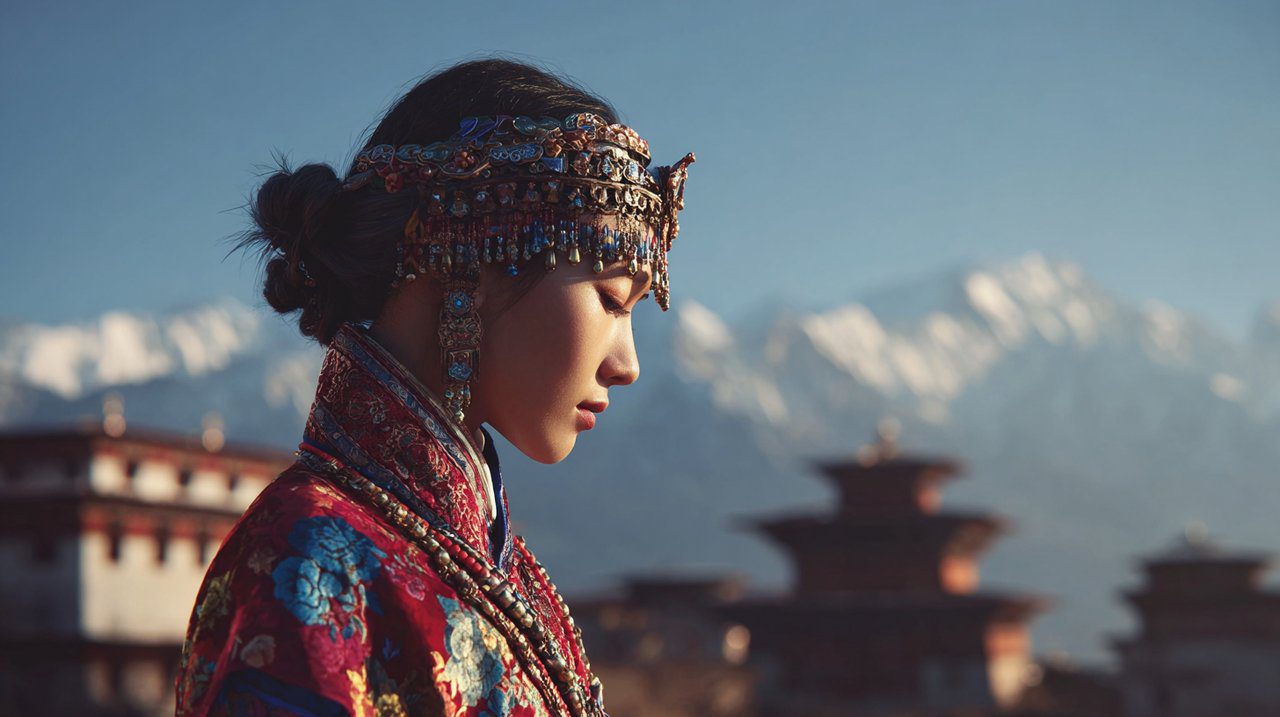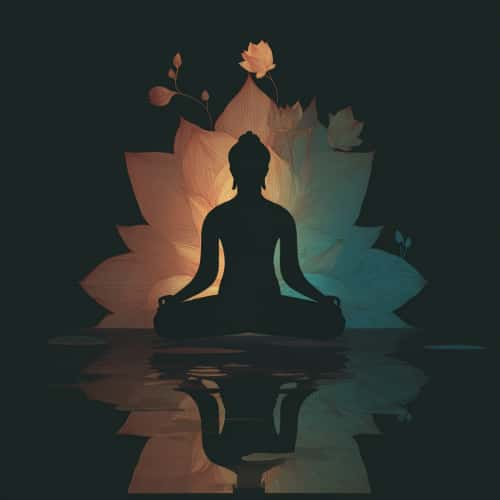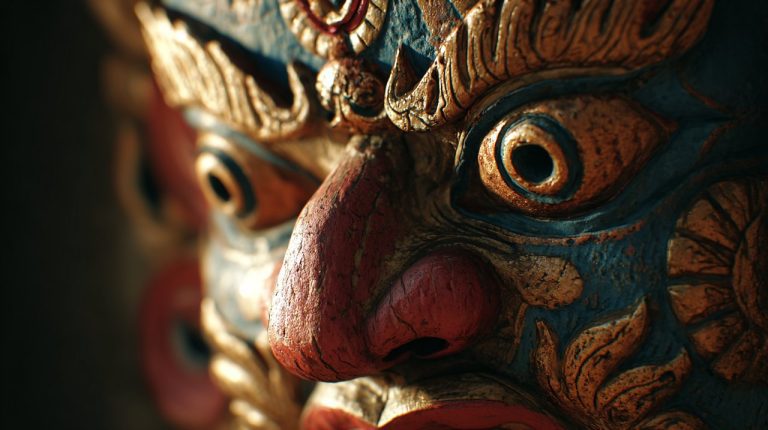Tibetan Attire: A Path to Inner Stillness
Let’s take a moment to imagine a place where every thread, every color, and every line of clothing is more than just fabric. It’s a living echo of centuries of spiritual wisdom.
This isn’t a dream; it’s the beautiful reality of Tibetan attire. These garments offer far more than simple protection from the elements; they are like wearable prayers, gentle teachings woven into cloth, and a vibrant, tangible expression of a deeply rooted spiritual heritage. Each fold seems to hold a quiet story, each color whispering a truth that invites us to listen.

Tibetan Attire: A Living Heritage Woven into Form
For generations, traditional Tibetan clothes have served a dual purpose. They offer refuge from the intense Himalayan climate, while also acting as a living tapestry of identity, status, and spiritual devotion.
What truly resonates with me is how their fundamental form has remained largely untouched for centuries. This speaks to a timeless wisdom, a design so profoundly aligned with its environment and deep spiritual essence that it simply endures, a quiet testament to a respectful way of life.
The Core Elements: Designed for Life
- The Chuba: This long, wrap-around robe is truly the heart of Tibetan attire. Often made from wool or sheepskin, it’s a remarkably thoughtful design. It provides both deep warmth and incredible freedom of movement across the challenging mountain terrains. Its loose fit offers more than just comfort; it’s a natural system for temperature regulation. If you need to cool down, simply slipping an arm out of a sleeve allows the mountain air to do its work. This simple, elegant adaptability is a lesson we can all carry into our own lives.
- Undergarments and Layers: Beneath the chuba, both men and women wear comfortable long-sleeved shirts and trousers. Women often grace their chuba with a vibrant, striped apron, known as a pangden. This beautiful piece is far more than an accessory; it’s an immediate, joyful symbol of marriage and blessings, openly shared with the world.
- Footwear and Headwear: Traditional boots, often crafted from felt or leather, are thoughtfully built for the rigorous demands of mountain life. Headwear, by contrast, offers a fascinating glimpse into regional and social expressions. It ranges from elegantly braided hair to elaborate, ornate hats adorned with precious stones, each one a unique narrative.
These garments, particularly those worn by nomads and villagers, are not products of mass production. Instead, they emerge from an intimate, almost spiritual understanding of natural materials and the unique conditions of their local environment.
The materials themselves—often hand-spun and naturally dyed—are more than just practical choices. They beautifully reflect a deep, inherent respect for the environment, a core tenet of Tibetan Buddhist philosophy. This is a profound humility that gently acknowledges our place within, rather than above, the natural world.
So far, we’ve gently explored the forms and practicality of these garments—how they shield and serve. But this is truly just the outer layer, isn’t it? The deeper magic, the profound resonance, lies in what they communicate without a single spoken word.
It’s about the silent language of color and pattern, a quiet conversation with the cosmos itself, inviting us to listen more closely.
Spiritual Symbolism: The Silent Language of Color and Pattern
The vibrant hues and intricate patterns we find in Tibetan attire are never chosen at random. This is a truly significant point. They are deeply symbolic, a visual echo of Buddhist cosmology and its foundational principles.
For me, each element is like a whisper of profound meaning, transforming everyday clothing into something truly sacred—a piece of Tibetan spiritual clothing. It feels as if the universe’s wisdom is gently woven into the very fabric.

Decoding the Universe: Colors and Symbols
- Colors of Wisdom: We often encounter the five wisdom colors—blue, white, red, green, and yellow—woven throughout. Blue quietly speaks of the vastness of the sky and boundless wisdom; white embodies the purity of liberation; red signifies the fiery passion of compassion; green represents the dynamic energy of enlightened activity; and yellow grounds us with the stability of the earth and the illumination of enlightenment.
To wear these colors is not merely a choice of adornment; it’s a subtle, personal invocation of their associated qualities, a quiet affirmation of our deepest intentions.
- Auspicious Symbols: We also frequently discover patterns that incorporate the eight auspicious symbols (Tashi Tagye), such as the endless knot, the lotus, and the dharma wheel. These are far more than mere decorative motifs.
They are lovingly believed to bring good fortune, offer gentle protection, and bestow spiritual blessings upon the wearer. It’s like carrying a quiet, pocket-sized universe of positive energy with you, a constant source of gentle affirmation.
It is this intricate web of meaning that truly elevates Tibetan attire beyond simple clothing. Every color, every line, every symbol is not just seen; it is deeply felt, quietly understood, and gently absorbed.
It serves as a constant, gentle reminder of the deeper truths that quietly underpin our existence.
In the Tibetan tradition, a garment is not merely fabric; it is an extension of one’s being, a canvas upon which the universe’s sacred geometry and colors are expressed. To wear these patterns is to carry a piece of the sacred with you, inviting harmony and positive energy into your life. Even the way a garment is draped or tied holds significance, often reflecting the wearer’s commitment to a path of mindfulness and reverence for life, much like how one chooses a spiritual symbol for personal adornment Buddhist Pendant Necklace Guide: Finding Your Spiritual Symbol.
We’ve now gently explored how Tibetan clothing is crafted and how it is imbued with such profound symbolism. But a deeper question emerges for us, in our modern lives: how do we truly connect with this ancient wisdom?
It’s not merely about what you wear, but rather how you perceive and thoughtfully interact with it. The true power, the heart of this connection, lies in the practice—in bringing these beautiful concepts to life within our own experience.
The Practice of Adornment: Weaving Body, Mind, and Spirit
Now, let’s gently move beyond purely intellectual understanding and engage with this concept in a truly tangible way. We will embark on a brief, gentle practice to connect with the essence of Tibetan traditional clothes and their innate power to ground us.
Consider this a small meditation, a quiet moment to truly feel this profound connection within yourself.
- A Moment of Connection: Find a quiet space where you can sit comfortably. Close your eyes gently, or soften your gaze. Bring your awareness to your breath, feeling it flow in and out, effortlessly. Let your mind settle, like dust in a still room.
- Invoking the Fabric: Imagine a piece of Tibetan fabric—perhaps a vibrant sash, a warm wool chuba, or a silken brocade. Allow its image to form in your mind’s eye. What color is it? What patterns adorn it? Notice these details without judgment, simply observing the beauty.
- The Tactile Invitation: Now, extend your awareness to the texture of this imagined fabric. Can you feel its warmth, its softness, or perhaps the cool, smooth glide of silk? Imagine it resting on your skin. What sensations arise? Allow your mind to truly feel the fabric, as if it were present in your hands.
- Embracing the Symbolism: As you hold this imagined garment, recall that it is more than just cloth. It carries the wisdom of generations, the blessings of sacred symbols, and the vibrant energy of the land. Feel how this fabric connects you to a lineage of peace, resilience, and compassion. Allow the colors and patterns to infuse your inner space with their meaning, like sunshine warming a room.
- The Inner Reflection: As you breathe, notice how this connection to the Tibetan attire influences your internal state. Do you feel a sense of calm? A spark of joy? A quiet strength? There is no right or wrong feeling, only observation. Let the essence of this adornment settle within you, a gentle reminder of your own inherent wisdom and connection to something larger than yourself.
Open your eyes gently when you are ready. This simple act of mindful engagement with the symbolic power of Tibetan attire can gently transform a mere object into a conduit for inner peace and profound connection.
It’s much like how the focused creation of Thangka art serves as a gateway to spiritual practice itself What Is Thangka Art? A Gateway To Spiritual Practice. Ultimately, understanding the depth and beauty of Tibetan attire offers us not just a glimpse into a rich culture, but a profound invitation to explore how the objects in our own lives can serve as anchors for our spiritual journey.
💡 Frequently Asked Questions
Traditional Tibetan attire is far more than just clothing; it embodies centuries of spiritual wisdom, a profound connection to the earth and heavens, and serves as wearable prayers, silent teachings, and a vibrant expression of a deep spiritual heritage.
The quintessential element is the Chuba, a long, wrap-around robe. Beneath it, men and women wear long-sleeved shirts and trousers. Women often wear a vibrant, striped apron called a pangden. Traditional boots and various forms of headwear complete the attire.
Tibetan attire incorporates spiritual symbolism through its colors and patterns. The five wisdom colors (blue, white, red, green, yellow) each represent specific Buddhist principles. Patterns often include the eight auspicious symbols, believed to bring good fortune, protection, and spiritual blessings.
The five wisdom colors frequently seen are: blue, representing the vastness of the sky and wisdom; white, purity and liberation; red, passion and compassion; green, karma and activity; and yellow, the earth and enlightenment.








